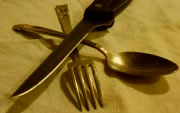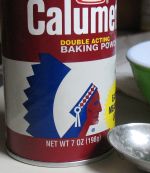
Conversion
Tables for Cooking,
Substitution Suggestions for Ingredients,
and a soupçon of intellectual property theft
as a cautionary
tale
1/5 teaspoon = 1 ml
1 teaspoon = 5 ml
1 tablespoon = 15 ml
1 fluid oz. = 30 ml
1/5 cup = 50 ml
1 cup = 240 ml
2 cups (1 pint) = 470 ml
4 cups (1 quart) = .95 liter
4 quarts (1 gal.) = 3.8 liters
Capacity: Metric to US
1 milliter = 1/5 teaspoon
5 ml = 1 teaspoon
15 ml = 1 tablespoon (3 tsp)
30 ml = 1 fluid oz.
100 ml = 3.4 fluid oz.
240 ml = 1 cup
1 liter = 34 fluid oz., 4.2 cups, 2.1 pints, 1.06 quart, .26 gallon
Weight
1 oz. = 28 grams
1 pound = 454 grams
1 gram = .035 ounce
100 grams = 3.5 ounces
100 grams of butter = about half a stick (1/4 cup)
500 grams = 1.10 pounds
1 kilogram = 2.205 pounds, 35 ounces
--------------------------------------------------------------------------------
Common cooking measurement conversions
16 tablespoons = 1 cup
12 tablespoons = 3/4 cup
10 tablespoons + 2 teaspoons = 2/3 cup
3 teaspoons = 1 tablespoon
48 teaspoons = 1 cup
1/4 ounce yeast = 2-1/2 teaspoons
2 cups = 1 pint
2 pints = 1 quart
-----------------------------------------------------------------
Temperatures
350 Fahrenheit = 176 degrees Centigrade/Celsius
150 F = 65 C
200 F = 95 C
250 F = 120 C
- - - -
Butter – in a baking recipe, shortening is virtually always better than butter. Don’t bother with margarine – it’s blended vegetable oil and water, so it won’t perform properly for baking OR frying. Go buy butter, real cow-squeezin's. A pound, and also a small tub of whipped butter with a tight-fitting lid that will get lost way in the back of the fridge and turn up some day when you’re desperate. To cut down on the oil used in baking, replace half the oil or shortening in the recipe with applesauce or mashed prunes.
- - - -
Flour – you can’t replace all the white flour in a recipe, except with unbleached white. But for more than half you can substitute oat, whole wheat, barley, almond, rice or garbanzo-bean flour. Combine several. Use only small amounts of buckwheat flour, teff, or oatmeal.
- - - -
Lemon juice – another thing you should always have in a forgotten back corner of the fridge is a little plastic lemon-shaped bottle of lemon juice. It will keep for 25 years. Have a fresh lemon on hand to use most of the time. The juice will substitute well for vinegar. Added to some yogurt, it’ll take the place of that all-gone Miracle Whip you need for tuna.
- - - -
Sugars: For a cup of honey, substitute ¾ cup maple syrup plus a quarter-cup white sugar. Or ¾ cup corn syrup, light or dark, OR light molasses, plus one-quarter cup sugar. Now, if you're slinging around a whole cup of honey, you really ought to review your glucose-consuming habits and give your pancreas a break. But to replace that entire cup of bee juice with sugar, toss in about a quarter cup of water and add a cup and a quarter of sugar (white or brown), plus a half-teaspoon of cream of tartar. More on THAT later.
- - - -
Milk – yogurt, thinned down a bit. Or use leftover vanilla ice cream, also diluted just a little.
- - - -
Buttermilk: I have never ever had a recipe calling for it, but you never know. Use almost a cup of milk, add a tablespoon of vinegar or lemon juice and let it set ten minutes. Or to the milk add most of two teaspoons of cream of tartar. Or use yogurt.
- - - -
Ricotta cheese – cottage cheese
- - - -
Sour Cream – equal amount of plain unsweetened yogurt
- - - -
Cream – nearly same amount of milk, with a couple tablespoons melted butter
- - - -
Vanilla – almond extract
- - - -
Walnuts – fer cryin’ out loud, chop up something else. Pecans are better anyway. Sunflower seeds will be harder, and some don't like them in baked stuff.
- - - -
Baking powder doesn't keep long and it's always expired when you go looking for it.
 Technical stuff: Baking powder is a mixture of edible chemicals,
“chemical leavening” ingredients. The three
components are a dry form of some acid, an alkali substance, and an
inert filler to prevent them from acting while they’re
stored. When you mix that teaspoonful into a recipe, the
liquid in the mix begins the process of an acid/alkali reaction,
producing gas that creates bubbles in the batter, making it rise.
If the recipe already contains a fair amount of acidic ingredients like
lemon juice or molasses, it will probably call for baking SODA, as
that’s all you need to spark the reaction. Technical stuff: Baking powder is a mixture of edible chemicals,
“chemical leavening” ingredients. The three
components are a dry form of some acid, an alkali substance, and an
inert filler to prevent them from acting while they’re
stored. When you mix that teaspoonful into a recipe, the
liquid in the mix begins the process of an acid/alkali reaction,
producing gas that creates bubbles in the batter, making it rise.
If the recipe already contains a fair amount of acidic ingredients like
lemon juice or molasses, it will probably call for baking SODA, as
that’s all you need to spark the reaction. Storebought baking powder is most often made from a starch filler, like cornstarch, sodium bicarbonate (baking soda), and the acid ingredient: cream of tartar (potassium hydrogen tartrate), alum, or “acid phosphate of lime.” Cream of tartar is obtained when tartaric acid is half neutralized with potassium hydroxide, transforming it into a salt. Grapes are the only significant natural source of tartaric acid, and cream of tartar is obtained from sediment produced in the process of making wine. To substitute for cream of tartar in a recipe, use a similar amount of white vinegar. |
To substitute for baking powder, take that measurement (yer teaspoon of Calumet or Clabber Girl) and use instead half that much of baking SODA, and another half of vinegar or lemon juice.